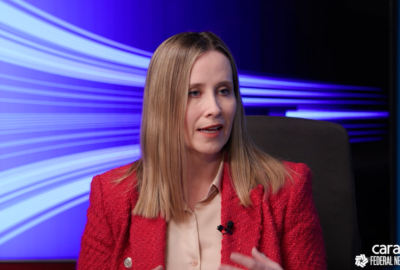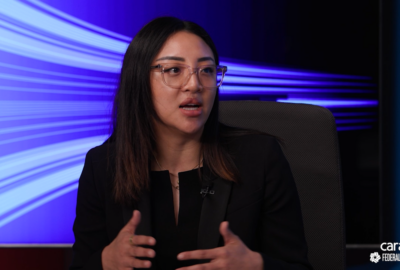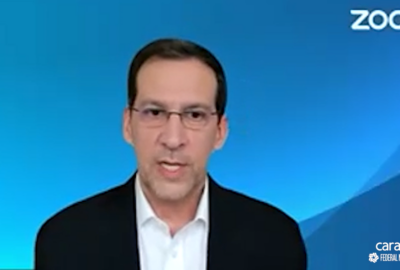Sponsored by Carahsoft
USA.gov: The trusted digital front door to federal services
GSA's Jessica Milcetich tells Federal News Network how USA.gov helps individuals find the government benefits and services they’re looking for quickly.
Federal websites receive about 2 billion visits every month, which represent about 80 billion hours of interactions with the public. More than half of those visits happen on mobile devices.
To deal with that massive volume of traffic, the General Services Administration offers USA.gov as a platform that helps individuals find the government benefits and services they’re looking for quickly.
Because USA.gov serves as an important first step in most customer journeys, the federal government considers the platform and GSA’s Public Experience Portfolio a High-Impact Service Provider (HISP).
Jessica Milcetich, director of customer experience for USA.gov, said the HISP designation “helps shine some extra light on some of the great customer experience work that we’ve been doing historically at USA.gov.”
“As part of the HISP program, there’s an extra focus and emphasis on understanding what your users need, and what they want, and building products with those needs in mind and talking to your customer regularly,” Milcetich said.
CX ‘baked into everything that we do’
GSA launched USA.gov nearly 24 years ago, and continuously updates the site with new features to meet the evolving needs of the American public.
“Customer experience is really baked into everything that we do. Any new feature or functionality that we’re rolling out on the site is because we’ve seen a need in our data, or we’ve heard something from some of our user testing, that something could be improved or made better. And so we work really hard to make sure we have that iterative development process where we’re listening to our users, collecting that data, figuring out how can we use that to make something better — whether it’s on our website, or through some of our other services. I think just being part of the HISP program really helps highlight how important that is across the government,” Milcetich said.
The Biden administration, in a December 2021 executive order, directed GSA to make USA.gov a “digital front door” for individuals seeking federal services.
USA.gov is not only a one-stop-shop for federal services online, but a trusted source of information. Milcetich said that’s especially valuable, since fraudsters often create lookalike websites, with the goal of capturing personally identifiable information.
“We do think of ourselves as that front door, that place you can start, if you don’t know where to start. I often think of us often as a wayfinding tool,” she said. “Somebody knows what they want to do or what they need to get done. They can put it into a search engine , and sometimes, they’ll see all sorts of things. As we all know, there are lots of bad actors on the internet. There’s confusion, there’s misinformation, there’s scammers — and having a trustworthy, authoritative place where you can say, ‘Oh, I see that .gov URL. I know what I’m going to get here is real information. It’s going to get me to the place that I need to go to do what I need to,’ is such a big part of what we do at USA.gov.”
‘Let people get the answer and get on their way’
USA.gov went through a major redesign last year. Among the changes, GSA incorporated more components from its U.S. Web Design System, with the goal of giving all .gov websites a consistent look and feel.
“If somebody lands on the USA.gov website, and they see that we format things in a similar way as other government websites, it just helps build that trust,” Milcetich said.
GSA is also piloting a tool on USA.gov that helps users to look up their elected representatives and their contact information.
“We had links to those places, that people could go find who their representative was. But one of the things we wanted to experiment with is, what if we had a way that people could enter their address, and then based on what they enter, they get the list of their federal, state, local officials, and any contact information that those folks have available to them,” Milcetich said.
USA.gov is also piloting a new benefits finder tool that helps direct users to the benefits they’re looking for by answering a few simple questions.
“The goal here is really to save people time and effort and to not overwhelm them — especially people who might be going through a stressful time and trying to figure out, ‘Well gosh, how do I just make ends meet right now?’ We’ve had that tool available in English and Spanish. We are learning a little bit about different pieces of functionality with that tool, and we want it to interact within our whole ecosystem of benefits information. It’s been a really exciting time to kind of see how users are interacting now that it’s kind of live on the site as opposed to maybe what we saw in some initial user testing or prototype,” Milcetich said.
GSA, she added, will continue to collect feedback from people and will continue working on the benefits finder tool for the rest of fiscal 2024.
USA.gov is part of the federal government’s recent push to deliver digital-first customer experiences, but GSA’s Public Experience Portfolio also operates a call center for individuals who either don’t have reliable internet access, or prefer to speak to a call center representative.
“Our emphasis has always been digital first. Let people get the answer and get on their way,” Milcetich said. “A big part of our work at USA.gov is to make that as smooth as possible for people.”
GSA also runs a Spanish-language version of the site, but USA.gov en Español is more than a translation of the English USA.gov.
“We’ve done a lot of research with the Spanish-speaking community. And our goal has always been to curate and create a product in Spanish that meets those needs. And that uniquely meets those needs, that isn’t just a one-to-one translation,” Milcetich said. “We want to get to the point that it’s not just a straight translation. You’re not popping it into a tool or having somebody sit and type word-for-word, a direct, perhaps literal translation. We have this concept that we ‘trans-create’ the message, so that the essence of the message is similar, if you were to look at what was available in English versus what was available in Spanish. But maybe there’s additional context that’s necessary. Or maybe there is a little bit more information or some more description about where we might be linking somebody to, to help build that trust for somebody who English might not be their first language.”
To make the platform more accessible to users with disabilities, GSA recently wrapped up a user research study in partnership with a nationally known vision rehabilitation center.
Through this partnership, GSA conducted a study where it worked with people who were either blind or had some sort of visual impairment and use assistive technologies to access a variety of things on the internet.
“We had very fruitful interviews and conversations to understand how government services online work for them with the variety of assistive technology that they use. We learned about their preferred methods of communication, how they wayfind on the internet,” Milcetich said. “We learned about some specific highlights they found on the USA.gov site, as well as some pain points. And it was so valuable to be able to watch and learn how somebody that uses assistive technology navigates a website, compared to somebody who is reading the text on the screen.”
Discover more about how to elevate your customer experience in the “Excellent, equitable and secure customer experience: A closer look at high-impact service providers” series.
Copyright © 2025 Federal News Network. All rights reserved. This website is not intended for users located within the European Economic Area.
Jory Heckman is a reporter at Federal News Network covering U.S. Postal Service, IRS, big data and technology issues.
Follow @jheckmanWFED






